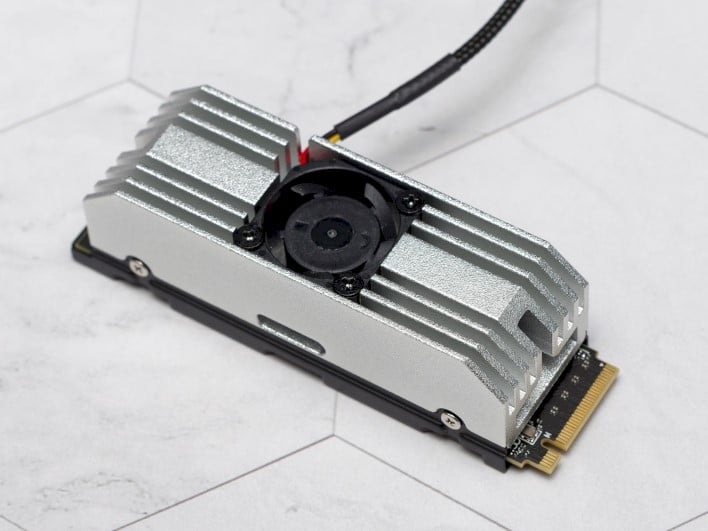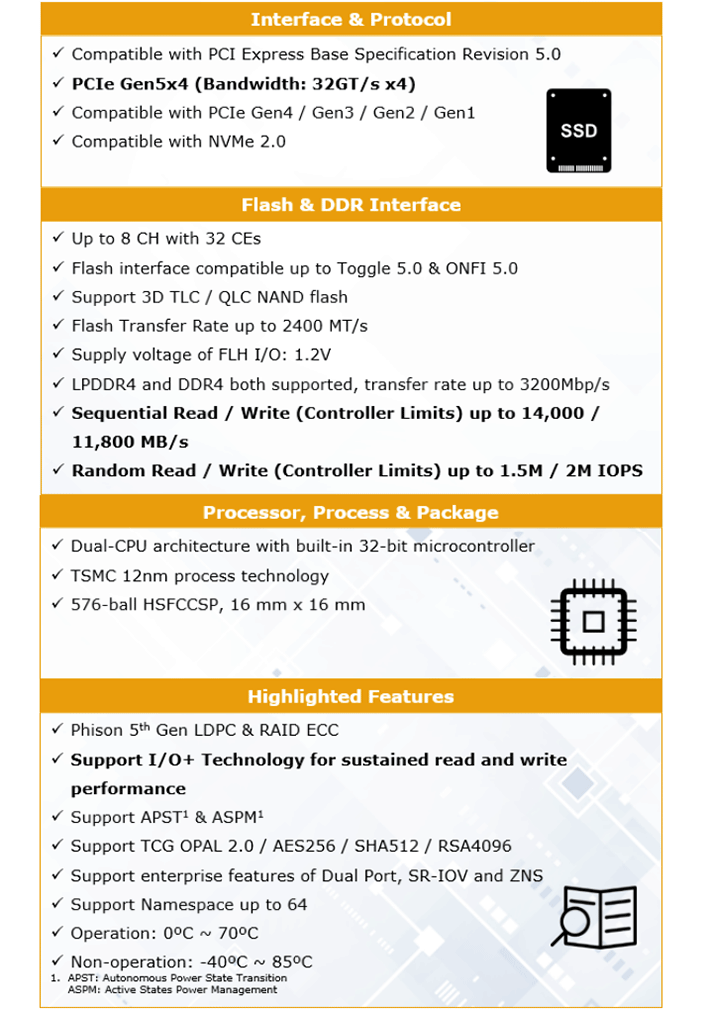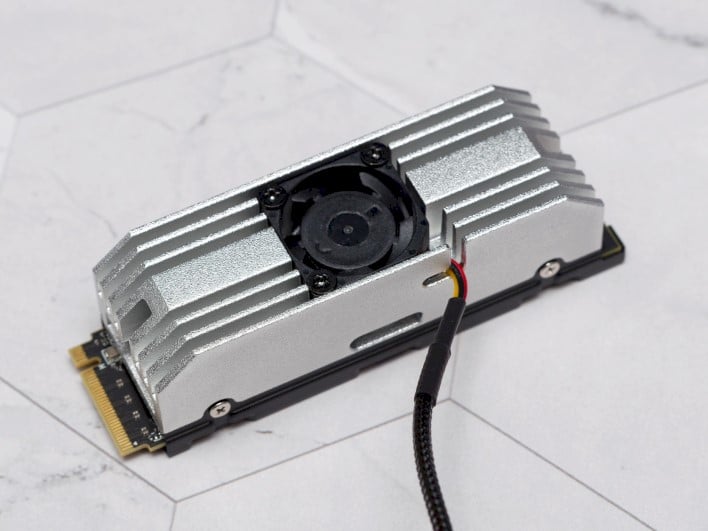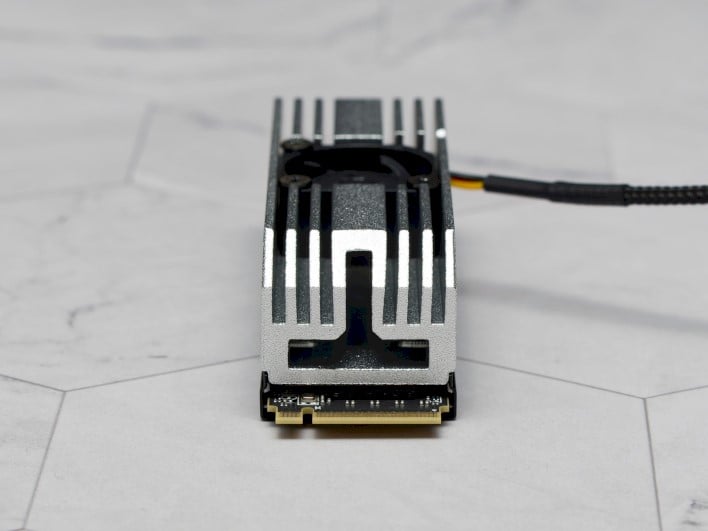Phison PS5026-E26 Max14um Preview: 2024's Fastest SSD Platform
Phison PS5026-E26 Max14um Preview: The Latest, High-Performance PCIe 5 SSD Platform
| Phison PS5026-E26 Max14um Preview: Coming Soon To An SSD Near You A mature controller, fresh firmware, and the latest high-performance NAND comes together in one of the fastest SSDs we've ever tested.
|
|||

|

|
||
Like last year, the Phison PS5026-E26 Max14um drive we’ll be showing you here is not a retail product, but rather a reference design for other manufacturers to use when building their own SSDs. It features the same E26 NVMe 2.0-complianct SSD controller, as well as a beefy DRAM cache, but this time around it’s paired to faster NAND flash and the drive benefits from an array of firmware and power optimizations that ultimately allowed for a significant performance uplift...
Phison E26 PCIe 5 NVMe SSD Specifications And Features
Phison PS5026-E26-based drives have evolved quite a bit since the controller first hit the scene. Early drives based on the Phison PS5026-E26 shipped with Micron’s B58R 3-bit per cell (TLC) NAND memory running at 1600MT/s. Those drives typically hit transfer rates of about 10GB/s, which was marginally faster than the best PCIe 4.0 SSDs available at the time. Later Micron released a B58R variant running at 2000MT/s, which pushed performance to about 12GB/s. This time around, Micron is readying an even faster variant of B58R running at 2400MT/s, which is the maximum flash transfer rate supported by the controller. The combination of the Phison PS5026-E26, another year’s worth of firmware and power optimizations, and 2400MT/s B58R pushes the performance of the Phison PS5026-E26 Max14um to a peak of about 14.6GB/s.
Otherwise the PCB layout and features of the drive are similar. And like current-gen Phison E26-based drives, the upcoming Phison PS5026-E26 Max14um flavors will require some sort of cooling to maintain top performance -- whether it comes by way of an active cooler like the reference model pictured here, or by the M.2 heatsinks built into today's top-end motherboards. We suspect Phison's partners will be introducing drives in this family, with and without included heatsinks, similar to what they did throughout 2023. If your motherboard has built-in heatsinks, you could save a few bucks on a bare drive, and if not, heatsink-equipped models will be available as well.
Phison PS5026-E26 Max14um PCIe 5 SSD Benchmarks
Under each test condition, the SSDs showcased here were installed as secondary volumes in our testbed, with a separate drive used for the OS and benchmark installations. Our testbed's motherboard was updated with the latest BIOS available at the time of publication and Windows 11 was fully updated. Windows firewall, automatic updates, and screen savers were all disabled before testing and Focus Assist was enabled to prevent any interruptions.
In all test runs, we rebooted the system, ensured all temp and prefetch data was purged, and waited several minutes for drive activity to settle and for the system to reach an idle state before invoking a test. All of the drives here have also been updated to their latest firmware as of press time. Where applicable, we would also typically use any proprietary NVMe drivers available from a given manufacturer, but all of the drives featured here used the Microsoft NVMe driver included with Windows 11.
HotHardware's Test System
| Processor: Intel Core i9-13900K Motherboard: MSI Z790 Godlike Video Card: GeForce RTX 3080 Memory: 32GB Micron DDR5-6000 Storage: ADATA XPG GAMMIX S70 Blade (OS Drive) ADATA XPG GAMMIX S70 (2TB) Seagate FireCuda 540 (2TB) ADATA Legend 970 (1TB) Samsung SSD 990 Pro (2TB) Crucial T700 (2TB) Phison PS5026-E26 Max14um (2TB) |
OS: Windows 11 Pro x64 Chipset Drivers: Intel v10.1.19284 Benchmarks: ATTO v4.01.01f CrystalDiskMark v8.0.4c x64 PCMark 10 Storage Bench 3DMark Storage Tests |
ATTO Disk Benchmark
ATTO is a "quick and dirty" type of disk benchmark that measures transfer speeds across a specific volume length. It measures transfer rates for both reads and writes and graphs them out in an easily interpreted chart. We chose .5KB through 64MB transfer sizes and a queue depth of 4 over a total max volume length of 256MB. ATTO's workloads are sequential in nature and measure bandwidth, rather than I/O response time, access latency, etc.


The Phison PS5026-E26 Max14um leads across the board in terms of read write bandwith. In the read test, the gap separating it from the Crucial T700 is small, but it opens up quite a bit in the write test where the Phison PS5026-E26 Max14um clearly leads with the largest transfer sizes.


These benchmarks measure IOPS instead of transfer rate, so naturally the numerical performance of the drive falls off as transfer size rises. The Phison PS5026-E26 Max14um, save for the very smallest of transfers in the read test, leads the rest of the way, especially in the write test.
CrystalDiskMark x64 Benchmarks
CrystalDiskMark is a synthetic benchmark that tests both sequential and random small and mid-sized file transfers using incompressible data. It provides a quick look at best and worst case scenarios with regard to SSD performance, best case being larger sequential transfers and worse case being small, random transfers.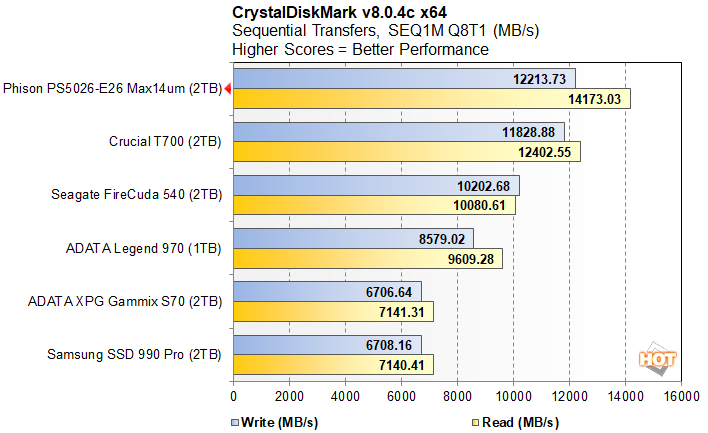



UL 3DMark Gaming Storage Benchmark
UL recently added a gaming-centric storage benchmark to 3DMark that leverages trace-based tests of actual PC games and gaming-related activities (such as streaming with OBS) to measure real-world gaming performance in a variety of scenarios. The tests include things like loading Battlefield V, Call of Duty: Black Ops 4, and Overwatch from the initial launch to the main menu, recording a 1080p gameplay video at 60 FPS with OBS while playing Overwatch, installing The Outer Worlds and saving game progress. And finally, copying the Steam folder for Counter-Strike: Global Offensive from one drive to another.

With the exception of a single test, where less than 1MB/s separated the Phison PS5026-E26 Max14um from the Crucial T700, Phison's latest platform led all of the other drives once again in terms of in-game transfer rates.

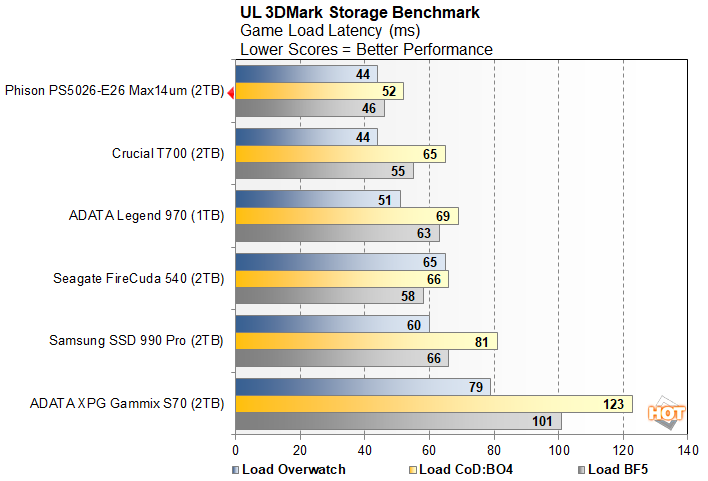
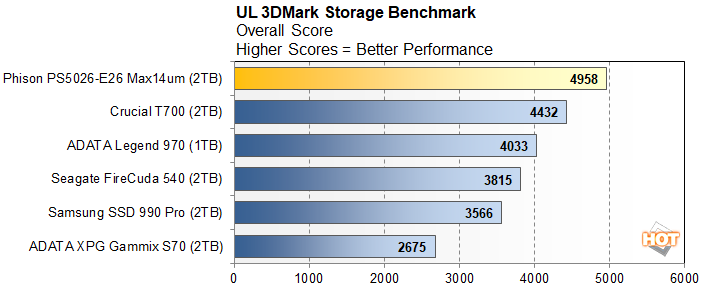
Those leading transfer rates and latency result in the top overall score we've seen from an SSD in 3DMark's storage benchmark yet.
UL PCMark 10 System Drive Storage Test
We like PCMark 10's new quick storage benchmark module for its real-world application measurement approach to testing. PCMark offers a trace-based measurement of system response times and bandwidth under various scripted workloads of traditional client / desktop system use cases.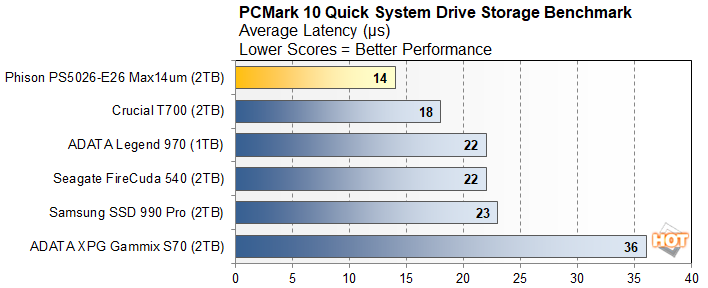

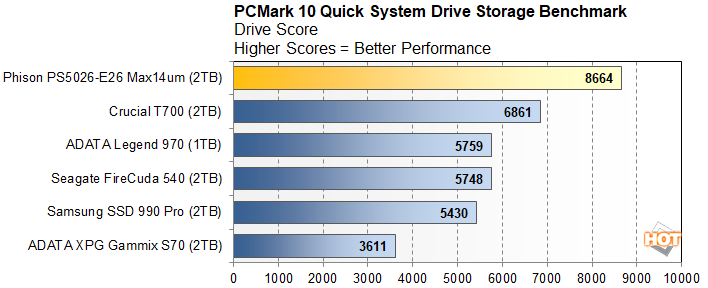
Finally, we have PCMark10's quick system drive benchmark, where the Phison PS5026-E26 Max14um dominated. The Phison PS5026-E26 Max14um offered the highest overall score we have seen to date, with the lowest latency, and it's the first drive to average over 1GB/s in this test as well.
Phison PS5026-E26 Max14um Preview: Good Things To Come
We’re not going to gush much in this conclusion because the benchmark numbers above speak for themselves, and this particular drive we tested is a reference platform that won’t be sold at retail. That said, it’s obvious Phison’s controller and tuning, and Micron’s latest B58R NAND running at 2400MT/s come together in what is likely to be the top, high-performance PCIe 5 SSD platform for 2024. We say “likely to be” because Samsung’s probably got something up its sleeve and we know InnoGrit's new 12nm, multi-core IG5666 controller is inbound as well, and drives using it will also be paired to Micron B58R NAND and offer transfers in the 14GB/s range.
Ultimately though, Phison has proven it is a leader in the space over the last couple of years. Virtually every top drive of 2023 was powered by Phison technology, and we’re sure this latest PS5026-E26 Max14um variant will be pervasive in the coming months. We’re definitely looking forward to getting our hands on retail drives based on this platform once they become available.

